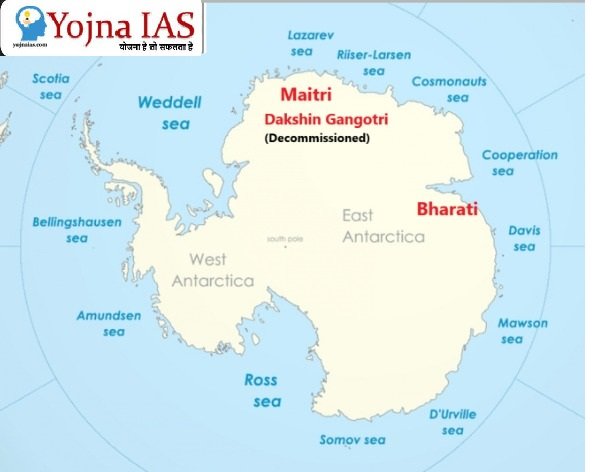20 Apr 2024 India’s new post office in Antarctica
This article covers ‘Daily Current Affairs’ and the topic details of ”India’s new post office in Antarctica”. This topic is relevant in the “International Relations” section of the UPSC CSE exam.
Why in the News?
In a recent development, the Department of Posts inaugurated a second post office branch at the Bharati research station in Antarctica, marking the first expansion in nearly forty years. As part of this initiative, letters designated for Antarctica will now bear a unique experimental PIN code, MH-1718, tailored for the new branch.
Importance of India’s Post Office in Antarctica
India’s presence in Antarctica in history
India’s Antarctic postal story began in 1984 with the inauguration of a post office at Dakshin Gangotri, the country’s first research station on the continent. This pioneering outpost, though eventually decommissioned due to ice submergence, stands as a historical landmark, a testament to India’s early foray into Antarctic exploration. The legacy continues at the Maitri and Bharati research stations, both equipped with functional post offices established in 1990 and beyond.
Collaboration for research
These Antarctic post offices serve as vital communication lifelines for researchers stationed at the remote bases. Letters carrying scientific data and personal messages travel between India and Antarctica, facilitating collaboration and keeping researchers connected to loved ones back home. The act of sending and receiving mail, even in such a harsh environment, provides a morale boost, reminding researchers of the world beyond the frozen expanse.
The growing presence of india in the International arena
Unlike a traditional post office operating within national borders, India’s Antarctic branches hold a unique significance. Antarctica, governed by the Antarctic Treaty promoting peaceful research and environmental protection, presents a special opportunity. The presence of these post offices subtly yet demonstrably asserts India’s peaceful presence and commitment to scientific exploration on the continent. It’s a way to plant a flag, not of conquest but of scientific curiosity and international collaboration.
Aligning with the Antarctic Treaty
The Antarctic Treaty plays a crucial role in governing the continent. It neutralises territorial claims, prohibits military activity, and emphasises scientific discovery. India’s postal network in Antarctica aligns perfectly with this spirit. It signifies India’s commitment to peaceful scientific pursuits and environmental stewardship in a region crucial for understanding our planet.
Boost to Morale
For researchers stationed in Antarctica for extended periods, being able to send and receive mail from home through a familiar Indian postal service can be a morale booster, helping them stay connected to loved ones.
About the Antarctic Treaty System
- The Antarctic Treaty System (ATS) stands as a cornerstone of international cooperation and governance in the Antarctic region. Signed on December 1, 1959, the treaty entered into force in 1961 and has since been joined by numerous nations, including major stakeholders in Antarctic affairs.
- It serves as a comprehensive framework for the management of Antarctica, encompassing governance, environmental protection, scientific research, and peaceful cooperation.
- Key provisions of the Antarctic Treaty include the demilitarisation of the continent, the prohibition of nuclear testing and disposal of radioactive waste, and the promotion of scientific research and collaboration among signatory nations. The treaty establishes Antarctica as a zone of peace and scientific endeavour, ensuring that it is used exclusively for peaceful purposes and scientific research.
- Furthermore, the Antarctic Treaty System encompasses a series of additional agreements and protocols aimed at addressing specific issues and challenges facing the region.
- These include the Convention for the Conservation of Antarctic Marine Living Resources (CCAMLR), which regulates fishing and marine resource exploitation in Antarctic waters, and the Protocol on Environmental Protection to the Antarctic Treaty, which designates Antarctica as a natural reserve dedicated to peace and science and outlines measures for environmental protection and conservation.
- It operates on the basis of consensus decision-making among its member states, ensuring that all decisions are made collectively and in the best interests of Antarctica and its inhabitants. Regular meetings of treaty parties, scientific committees, and expert groups facilitate communication, cooperation, and the exchange of scientific knowledge and expertise.

India at the Antarctic
India’s Antarctic Programme represents a significant commitment to scientific research, environmental conservation, and international cooperation in Antarctica. Central to this programme are India’s three research stations strategically located in the Antarctic region: Maitri, Bharati, and Dakshin Gangotri.
- Dakshin Gangotri (1983-1991): This pioneering research station, established in 1983, marked India’s initial foray into Antarctica. Notably, it was the first time an Indian team wintered over on the continent, a crucial milestone for scientific research. While eventually decommissioned due to being submerged by ice, Dakshin Gangotri’s legacy lives on as a symbol of India’s early Antarctic endeavours.
- Maitri (1989): Commissioned in 1989, Maitri stands as India’s first permanent research station in Antarctica. Located near Schirmacher Oasis, this all-weather station allows researchers to conduct year-round scientific studies in various disciplines, including atmospheric sciences, biology, geology, and glaciology.
- Bharati (2012): India’s most recent research station, Bharati, was inaugurated in 2012. Situated in a region with minimal snowfall, this station facilitates research on upper atmospheric studies, coastal processes, and the impact of climate change.
Download Yojna daily current affairs eng med 20th April 2024
Prelims practise question
Q1. Consider the following statements:
- Emperor penguin is native to Antarctica
- Aurora borealis phenomena cause the sky to appear greenish-blue in Antarctica
- Ross Ice Shelf is the largest ice shelf in Antarctica
How many of the above statements are correct?
(a) Only one
(b) Only two
(c) All three
(d) None
ANSWER: B
Mains practise question
Q1. Analyse the strategic importance of Antarctica in India’s diplomatic endeavours, exploring how the nation’s involvement in Antarctic affairs contributes to its stature as a responsible global actor and enhances its soft power on the international stage.
I am a content developer and have done my Post Graduation in Political Science. I have given 2 UPSC mains, 1 IB ACIO interview and have cleared UGC NET JRF too.


No Comments